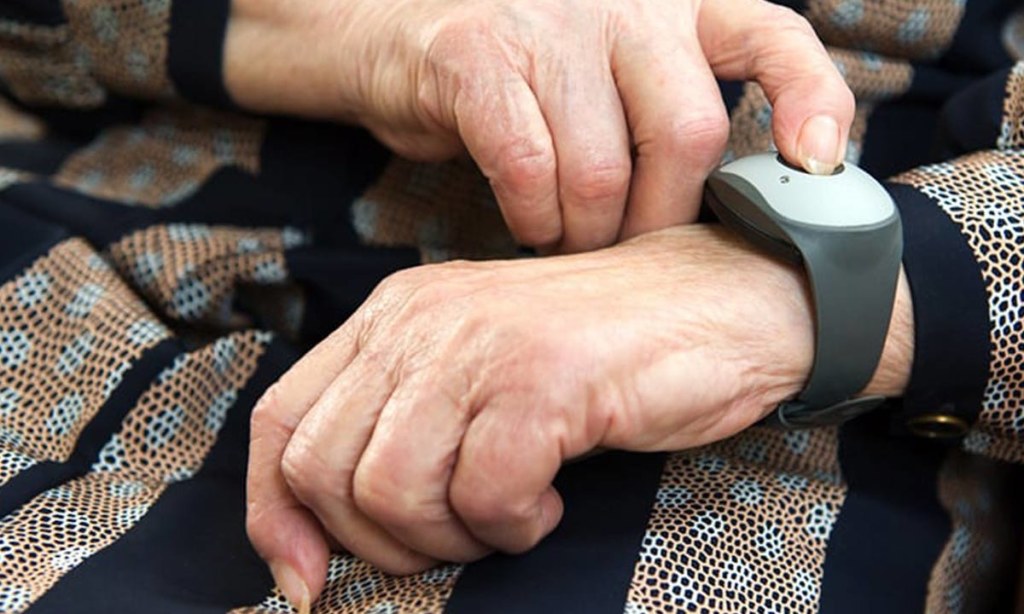What Is a Medical Alert Bracelet?
A medical alert bracelet, or medical alert necklace, is a device that can operate alone or connect with some home medical alert systems. Depending on the device features, the user can tap the button on the bracelet to connect to the medical alert system’s helpline or operation center to send staff or emergency services to the home. These devices can also contain information about the patient’s pre-existing conditions that are crucial to their treatment, such as conditions like diabetes or asthma.
You may be familiar with the Life Alert commercials with the tagline “Help! I’ve fallen, and I can’t get up!” That slogan is essentially the exact function of a medical alert bracelet—to connect the user with the best source of help if such an accident should arise.
You may be familiar with the Life Alert commercials with the tagline “Help! I’ve fallen, and I can’t get up!” That slogan is essentially the exact function of a medical alert bracelet—to connect the user with the best source of help if such an accident should arise.
Some medical alert bracelets also come with features like automatic fall detection, which is useful in cases where the user cannot speak or hit the button on their device because they are injured from the fall.
Contact Your Insurance Provider
As confusing as many would agree insurance policies are, it’s worth a shot to sort through them and explore the possible options they present for providing you with a free, trusty emergency device. Traditional insurance policies do not cover medical bracelets or necklaces, but Medicare and Medicaid plans sometimes do.
Medicare

If you’re enrolled in Medicare, it’s possible to find a policy that compensates you for a medical bracelet. However, before delving up to your elbows in Medicare policies, keep in mind:
- Medicare Part A and Medicare Part B will not cover expenses for medical alert bracelets.
- Medicare Part C, otherwise known as Medicare Advantage, can cover part—or all—of the cost for medically necessary devices, of which a medical alert necklace or a bracelet would fall under if the insurance program for your policy deems it medically necessary.
- Upgrading to Medicare Part C will cost extra because it is considered a premium policy.
Coverage for emergency medical devices varies depending on your state, so it’s best to check your policy before fully committing to buying one. It’s best to get a prescription from your primary care provider to present as justification for your Medicare provider.
Don’t forget: To be eligible for Medicare Part C, you must be currently enrolled in Medicare Part A and Medicare Part B.
Medicaid

If you’re not having any luck with getting your Medicare policy to cover medical ID alert bracelets or necklaces, don’t worry! There are other avenues to consider, such as Medicaid eligibility.
Medicaid wants to do everything it can to keep you safe and sound at home. For this reason, an emergency medical alert device—called a PERS (Personal Emergency Response Services)—is usually considered a justifiable expense for those enrolled.
Depending on how Medicaid is implemented in your state, some programs can help cover the costs of emergency medical alert systems. If there aren’t any programs available for coverage, you can also request waivers from Medicaid to help front the cost for your med bracelet.
Medicaid Programs for Emergency Medical Alert Systems
- Money Follows the Person
- Self-Directed Services
- Medicaid Personal Care Attendant Programs
Contact a Local Hospital

Thousands of hospitals across the nation have helped elderly citizens get free or reduced-cost medical alert bracelets. It’s worth it to call your local hospital or trusted family doctor and check to see if they can provide you with one or have a program available to cover the cost.
If they’re unable to provide you with what you need, don’t worry! They may still be able to redirect you to a local program or organization that can help you with covering the cost.
Look into Local Organizations
Many local organizations across the United States can help pay for your or your loved one’s medical alert system. If calling local hospitals for further information isn’t yielding any luck, check with your state’s available local programs.
Agency On Aging
If you can’t find any state-specific programs, try contacting the Area Agency on Aging (AAA).
AAA is a national program that sometimes has emergency bracelets included in its mission to keep elderly adults safe and healthy in their own homes.
Look into contacting your local chapter to explore what options are available to you for receiving a free or reduced cost emergency medical alert system. If they’re unable to assist you at this time, they will connect you to other programs that can.
Benefits for Veterans
Government programs for elderly veterans provide approved free medical alert devices for users who meet specific criteria. These complimentary devices may not be the latest on the market, but if you or your veteran loved one wants to save money, this is a great option to explore.
Department Of Veteran Affairs (VA)

If you or your loved one are already enrolled in Medicare Part C, coverage will defer through your provider. If not, the VA will cover approved emergency medical alert devices with a recommendation from a doctor who will specify the device needs (fall detection, 24-hour support, in-home monitoring, etc.).
Keep in mind that adding additional features to your medical alert device could increase the price, potentially changing a free medical bracelet to one with a reduced cost. Discuss your various features and pricing options with your doctor and the VA.
Tricare

If you’re a veteran enrolled in Tricare For Life (TFL), the organization may cover a medical alert system. Because Tricare is a coverage option only available to veterans enrolled in Medicare Part A and Medicare Part B, your Medicare provider will have more information on TFL policy and eligibility.
Contact Medical Alert Providers
Another option for free or reduced cost medical ID bracelets is cutting right through the middlemen to deal with the providers themselves. If there is a particular medical alert system that fits your needs, contact the provider to see if there are any eligible discounts or scholarships they offer that can help cover the cost. Medical alert providers typically understand the common financial strains of their elderly customers, so they should be able to point you in the right direction for getting the best deal for your medical ID bracelet.
If there is a particular medical alert system that fits your needs, contact the provider to see if there are any eligible discounts or scholarships they offer that can help cover the cost.
If You’re Ineligible for a Free Medical Alert Bracelet
Don’t worry. There are still options for discounted medical alert systems that come with a medical ID bracelet. Be sure to check our comprehensive list to find the medical alert system for you.
Low-Cost Medical Alert Bracelets
Our pick for the best low-cost emergency medical alert device is Bay Alarm Medical. The Bay Alarm starts at a monthly subscription fee of $19.95 and comes with a medical ID alert necklace instead of a bracelet.
No Monthly Fee Medical Alert Bracelets
If you’re trying to avoid monthly fees for your emergency alert services, there are options available for that, too. Review our list of medical alert systems with no monthly fee, starting as low as $50, and see which deals will benefit you or your loved one the most. We recommend purchasing only one of these devices if you’re not looking for extra features, such as fall detection.
Keep in mind that while having no monthly fee will be better for your wallet, going this route may be lower in quality because the system is not monitored. If you need the extra reassurance of having fall detection and an online support system, a medical bracelet system with a monthly fee would be more beneficial in the long run.
Bottom Line
Hunting for the most affordable or free option can be overwhelming, but you don’t have to take it all on yourself. If it’s too hard to find the information you need to consider your options on any provider or product websites by yourself, let someone like a caregiver or a family member help.
In addition, your doctor, on-duty support staff, and provider staff are there to help guide you through the process of finding the best medical alert equipment for the best price. Even after you receive your free or discounted device, if it’s not working for your situation, please let your provider know so they can help you return it at no cost and point you to another product.
Why You Can Trust Us
We have a devoted team of experts behind the scenes who are always ensuring our information is up-to-date and accurate. We care about the health and lifestyle of all elderly citizens, and our passion is to give them the tools they need to prosper safely in the comfort of their own homes.


